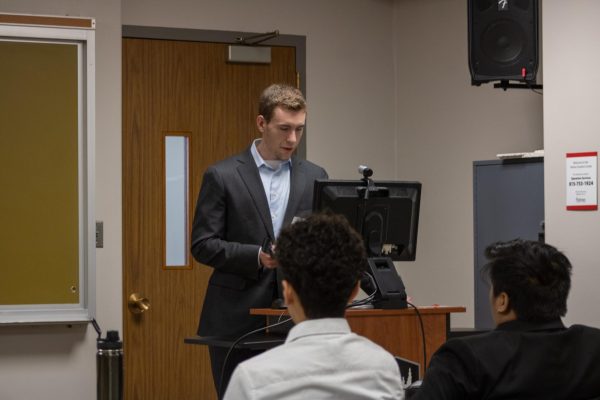In perspective
December 5, 2002
Worried about finals? Why not sit back and relax from 6:30-9:30 p.m. this Sunday night at the Holmes Student Center’s Heritage Room at the communication department’s documentary film screening? All of the documentaries are made by NIU students and they average around 15 minutes in length.
“In media, we make pieces to be shared,” said communication professor Laura Vazquez, who teaches COMS 426 and organized the screening. “The experience of showing your work in front of an audience is important. You get to see a perspective that you, yourself, could never see.”
Professors like Vazquez all agree that constructive criticism is an essential element for a student in a creative field. There is no better way to get such criticism than with a large audience, so everyone interested is encouraged to attend. But don’t walk in expecting to see a bunch of low-quality, amateur pieces.
“In the couple of years that I’ve been here, I’ve seen huge leaps in quality,” Vazquez added. “All of these films are really well done.”
Almost all of the films being shown are what Vazquez refers to as “personality pieces.” The students’ assignment was for them to select a particular individual or group of individuals and create a glimpse of what that person or group is like. Through countless interviews and hours of research, many of the students found deeper issues inside of their topics than just who their subjects are and what they’ve done.
Take “Karaoke King” by Kim Piper and Marc Barbour. It’s a story of a karaoke singer that asks more than what his favorite songs are. The film asks how one can have a family while struggling to achieve their own dreams. Is there a point when parents should put their own dreams aside for the well-being of their children?
Then there’s “Lights, Camera, Action,” by Natalie Wilson and Edward Quinn, about the owner of a modeling school for African-Americans. The film argues that the reason many African-Americans are not involved in fashion modeling is their lack of education and training in the field.
“Gravity: Story of the Groundhogs,” a film by Kristy Griffin, Mark Gresholdt and Charles Morrison, is about a breakdancing group that encourages us to consider why break dancing has less cultural value than other dance forms. “What It Takes,” by Josh Austin and Josh Kuhl, is the tale of an aspiring group of local musicians while “Verne” by Trent Dempsey and Jake O’Reilly, tells the tale of a Rockford area music fan. “Making of an Angel” by Shawn Bernal, Jaysin Osterkamp and Tommy Paulson gives a behind-the-scenes look at the making of a student film. “The Face Behind the Empty Bowl,” by Sarah Wasson and Angela Johnson, is about a sorority house chef. “Labor of Love” by Melissa Meyerhoff and Carissa Diesing, is the story of JBTV creator Jerry Bryant. “No Lights, No Show,” by Neal Cervone, Steve Woertendyke and Sean Riley, gives a behind-the-scenes look at the lighting director of the Vic Theater in Chicago. “DeKalb Solitaire” is an autobiographical piece about Pat Lind’s travels out west. “The Raven’s Grinn Inn” by Lynette Kleisner tells about a haunted house in Mt. Carroll.
While all of the students had the same assignment, all of the films vary through content approach and style. However, they all have one thing in common — all the students are looking for as big an audience as possible.
People need to see that the communication department isn’t just kids watching movies all day,” said Melissa Meyerhoff, co-creator of ‘Labor of Love.’ “It’s very important to us. These are our lives.”













